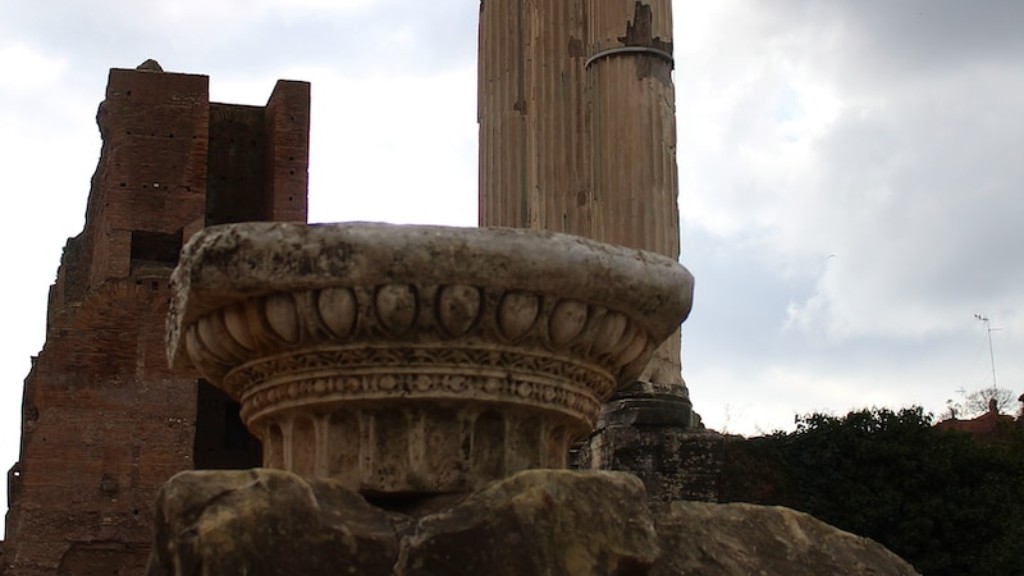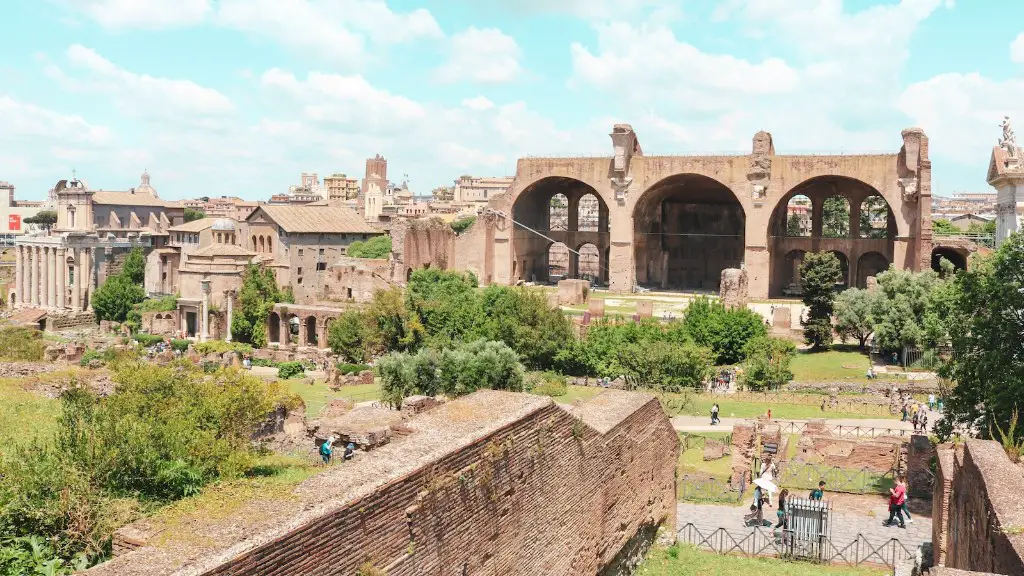Public baths were an important part of life in Ancient Rome. The public bathhouse was a place for people to bathe, socialize, and take part in physical activities like wrestling and swimming. Public baths served both the physical and social wellbeing of the people in Ancient Rome and beyond.
The practice of bathing and washing in public baths dates back to before the Roman Republic in 600 BC. Initially these baths were developed as a way to promote cleanliness and health, especially in densely populated cities and settlements. As the practice became more commonplace, the Roman government saw the benefits of having public baths and so they began to fund and build baths in various towns and cities.
The building of public baths was a way for the government to show their power and status, and for many Romans this was a place of recreation. They could meet and converse with other citizens, read, listen to live music, enjoy a meal and play sports. Public baths also had a symbolic importance, where people could display their wealth and status. The wealthy citizens had access to the more luxurious baths, such as those with hot spring water or the more opulent and impressive public baths like the Baths of Caracalla.
Public baths usually consisted of multiple rooms, each with its own purpose. The most common rooms were the apodyterium (for undressing), the caldarium, tepidarium, frigidarium (for warm, cool, and cold baths, respectively), and the sudatorium, a steam room. In some cases, there were also changing rooms, swimming pools, and food and drink areas.
In the Apodytrerium, people would disrobe and visit the Tepidarium, which was a warm room heated by a furnace. From the Tepidarium, they would move to the Caldarium, a circular room heated by a hot steam produced from an oven next to the room. In the Caldarium, people would stay for a while and exfoliate their skin using pumice stones from volcanic rock. They would then move to the Frigidarium, a large pool with cold water used for cooling down and refreshing after a long hot bath. After that, the people would go to the Sudatorium, a steam room where they could sweat and relax for a while.
Not only did people use public baths for physical hygiene, but also for religious rituals. To give thanks and make offerings to the gods, many people would spend time in the baths and pray. Hence, the public baths also acted as a temple of sorts, where people could congregate and practice religious ceremonies.
In conclusion, Ancient Rome was a highly developed society, and public baths were a crucial part of daily life. They provided a place to bathe and cleanse the body, but more importantly, they served as a social gathering place. With their elaborate structures, they also served as a symbol of status and power, a place where people could connect with each other and the gods and recharge with a hot soak and conversation.
The Uses of Hot Springs in Ancient Rome
In addition to the public baths, hot springs were seen as a major health benefit. Hot springs are sometimes referred to as “thermal baths” as they are a type of mineral spring water that is especially warm and soothing. The ancient Romans utilised such springs for partly medical purposes and for entertainment. Throughout Ancient Rome, there were plenty of hot springs around, and visitors could enjoy a relaxing hot spring dip. The hot springs were also believed to have medicinal properties, and those suffering from illnesses would often visit the springs to seek relief.
A noteworthy example of Ancient Roman hot springs was the Terme di Agrippa, located in the city of Rome and constructed around 25 BCE. This particular hot spring was designed by the architect Marcus Vipsanius Agrippa, a close friend of the esteemed Julius Caesar. Throughout the Roman Empire, similar structures were built; many had baths of various sizes, fountains and gardens, as well as residential quarters.
As the popularity of the hot springs grew, so did the infrastructure around them. Many areas of Ancient Rome had elaborate stone pools to enjoy the hot spring water, and these pools became popular for both physical and social activities. People would come to the springs to enjoy swimming, conversation, and entertainment. The wealthy were especially able to take advantage of the luxurious experience provided by a hot spring soak.
Hot springs were one of the major health benefits of Ancient Rome. From medical treatments to hours of fun, these springs were ideal for the people of Rome. Not only were the hot springs seen as a health benefit, but also as a symbol of power and wealth. They provide an avenue for people to show off their affluence and social status.
The acceptance of hot springs as a recreational activity gradually faded away as other activities took its place, but they still remain an important part of the Roman experience. In addition to providing health benefits, they also serve as a reminder of Ancient Rome’s significant contributions to society.
The Social Aspect of Public Baths in Ancient Roman Times
Public baths in Roman times were much more than just places to get clean. They served a variety of purposes; from places for people to meet friends and conduct business to locations for philosophical discussions and leisure activities.
The public baths of Ancient Rome were communal areas. They provided an opportunity for social mixing with no regard to class or wealth. This type of interactivity was a rarity in Ancient Rome because there were usually barriers between people of different statuses. Public baths were also places where Roman citizens shared news, enjoyed entertainment, and discussed various ideas.
Public baths were host to a variety of activities. Many people chose to spend their time at the baths reading, writing, and engaging in discussions. It was a popular pastime for students and teachers alike to sit in the wet areas and enjoy the cool water as well as philosophical disquisitions. People can still be heard discussing current events today, hundreds of years later.
Not only were baths used for intellectual discussions, but also for leisure activities such as boxing and swimming. At some public baths, there were even indoor arenas, where Romans could watch athletic events and competitions. These events ranged from discus throwing to horse racing.
In Ancient Rome, public baths were also places of celebration and amusement. They served as venues for extravagant dinners, parties, and theatre performances. Furthermore, they were centres not only of Roman life but of spirituality, as evidenced by the diverse selection of shrines, altars, and temples that could be found in them.
It is clear that Ancient Rome’s public baths served more than just a hygienic purpose. They were places of intermingling and recreation, of intellectual and leisure activity, and of faith and celebration. They were even more than just quaint social gathering spots – they were integral to Roman life and culture.
The Significance of Ancient Roman Public Baths in Modern Times
With a deeper understanding of the magnitude of Ancient Roman public baths, people can now appreciate the relevance and importance of them in the modern world. Today, public baths act as a reminder and appreciation for the Ancient Roman culture, and for the engineering, architecture, and societal advances that were achieved during this time.
Due to the growing population of large cities, modern public baths are being utilised as a way to promote cleanliness and health, as was originally done in Ancient Roman times. In some parts of the world, public baths are used as a form of natural healing, as they are said to have restorative benefits.
Most importantly, public baths are used to bring the community together. They are not just places to relax, but also areas of gathering – much like those of Ancient Rome. They give people the chance to socialise and make new acquaintances, and are also a refuge for physical and mental wellbeing.
The modern world has adopted many societally beneficial practices from Ancient Rome and public baths are a prime example of this. With their positive and restorative qualities, public baths have maintained their importance since Ancient Roman times and will continue to be an important part of society for centuries to come.
The Design and Engineering of Ancient Roman Public Baths
Roman public baths were some of the most advanced and impressive structures of their era. Not only were they great places for socialising and relaxing – they were feats of engineering.
The construction of a public bath was very complex and required specific knowledge and skill. Architects and engineers used their knowledge and resources to ensure the building was both safe and stylish. One of the major components of a public bath was its plumbing system, which was surprisingly advanced and resilient. This system was responsible for transporting water from the outside and directing it to the various areas of the bathhouse – hot and cold rooms, swimming pools, and other areas.
The baths were also covered in an incredible array of artwork and frescoes, making them even more impressive. In some instances, architecture and statues were used to create certain effects within the bathhouse, utilising light and shadow to create a sense of grandeur.
Today, the significance of these structures is still appreciated. Architects and engineers often look to Ancient Rome for inspiration on their own projects, admiring the technological advances and thought-provoking designs that went into the construction of public baths.
In conclusion, Ancient Roman public baths were not only places of leisure and bathing, but were marvels of engineering. They were made up of elaborate plumbing systems, eye-catching artwork, and striking architecture. Although the relevance of these structures within society may have changed over time, their importance is still grateful and their influence still felt today.
The Effects of Public Baths on Roman Culture
Public baths had a great impact on Roman culture and society as a whole. For centuries, public baths served as a place of relaxation and leisure for people from all social classes. This allowed for a unique form of public interaction that was very different from the everyday lives of Roman citizens.
Public baths were seen as great meeting places and centres of public opinion. Not only did they provide an avenue for citizens to express themselves and interact with each other, but also to discuss topics of philosophy and engage in deep debates about politics and current events. This environment of open discussion contributed to the overall intellectual growth of Roman culture.
By providing a centralised meeting space, public baths also enabled citizens to share ideas and knowledge, thus promoting learning and contributing to advancements in Roman society. Furthermore, they were also key locations for various entertainment activities like sports and theatre, giving people the chance to enjoy their leisure time.
The influence of public baths went beyond their role in cultural advancement and enrichment. They served as a gathering and connecting place, enabling people to socialise and meet new people with similar interests. As such, they provided a sense of security and community which was essential for a functioning society.
In conclusion, public baths had a profound impact on Ancient Roman culture. They provided a relaxing space for people to socialise and discuss ideas, and for entertainment activities to take place. Furthermore, by bringing people together and thus enabling the sharing of knowledge and experiences, public baths fuelled an environment of intellectual growth and cultural advancement. This is a legacy that is still recognised today.





